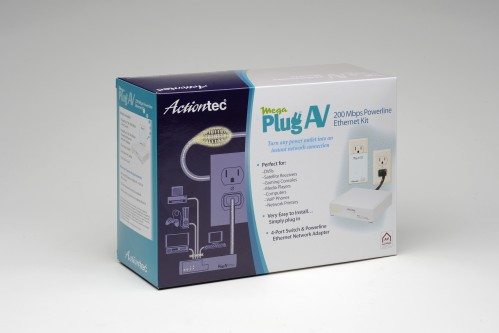
The next time I purchase a house I will look for one that has Ethernet wired to all the rooms, but until that happens I need a way to get high speed LAN access in different areas of my home. WiFi is too slow and unreliable. One of the possibilities is a technology called Powerline Ethernet. The MegaPlug AV Powerline Ethernet from ActionTec kit is one option.
I had previously reviewed the Netgear Powerline AV Ethernet Adapter and found that it satisfied my needs, but it would have been better if there were more ports to plug devices into. The MegaPlug AV purports to provide the same connection experience with the addition of a 4-Port integrated switch.
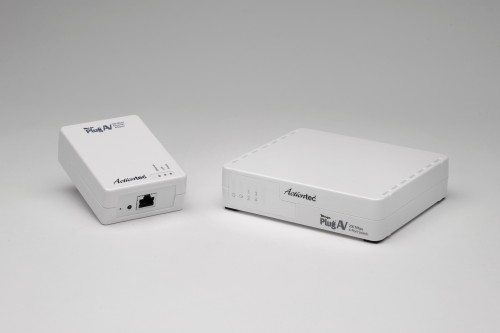
The kit consists of 2 transmitter/receivers where one is a single port device and the other has the 4-Port switch.
Features:
- Plug-N-Play
- Any electrical outlet will work
- Supports HomePlug speeds up to 200 Mbps
- HomePlug Av compatible
- More secure than wireless networks
- Works with any Ethernet enabled device
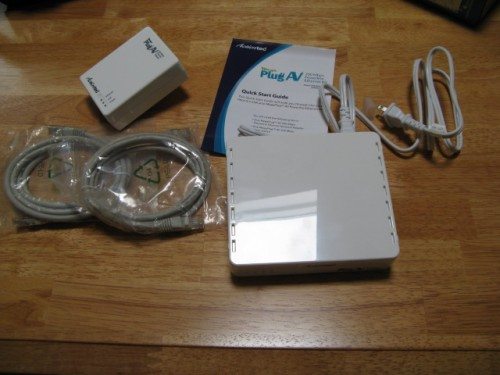
In the box:
- The devices as mentioned above
- Quick start guide
- Two Ethernet cables
- Power cord
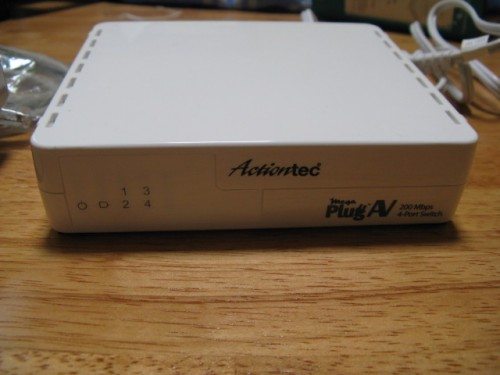
The Ethernet adapter plus 4-Port switch from the front.
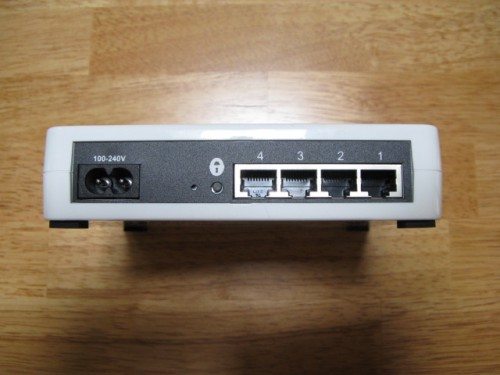
And from the back showing the 4 ports. The button under the lock symbol allows the encryption of the data. Because I live in a detached home I don’t need it, however, for those living in multi-unit dwellings, setting encryption would be a good idea.
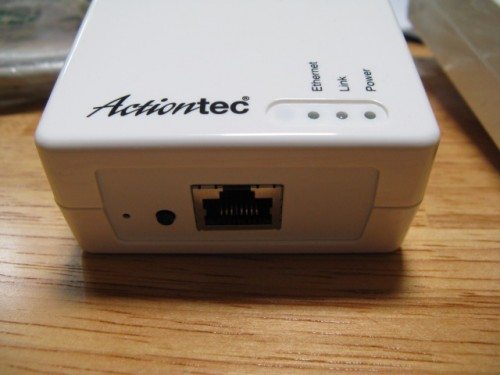
The single port Powerline adapter. It also has the button to enable encryption. Not shown is the flip side which has the 2 prong AC plug built-in. The device has an integral power supply and looks like a wall wart when plugged into the wall.
Installation is a snap, entailing plugging the devices into a convenient AC outlet and then running an Ethernet cable from your modem or router to one device and then a cable from the other Powerline adapter to the device you wish to connect to the LAN.
As my current Powerline setup also states that it conforms to the PlugAV specification, I should then be able to plug the Actiontec devices in the wall and they should work mixed in with the Netgear devices!
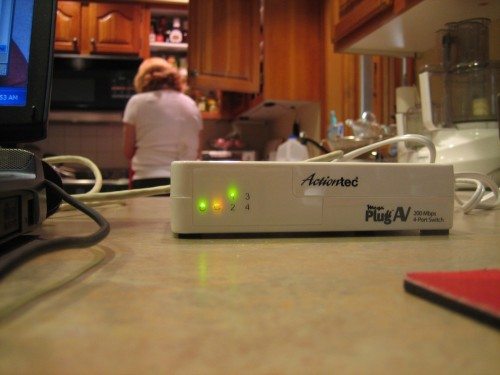
To be honest, I was surprised that it worked. In the above photo the 4-Port ActionTec device is in the kitchen with a laptop plugged in and the LAN also includes a Netgear device for my Linksys Media Center and the adapter at the router/modem end is also from Netgear. I tried different combinations of all 4 devices (2 x Netgear and 2 xActionTec) and all worked fine. So my conclusion is that PlugAV truly is a standard and there is interoperability between compatible devices.
One thing that ActionTec doesn’t supply is a utility to monitor the network. They rely upon the indicator lights on the units which give a broad estimate of the throughout. I had to dig through their website and online documentation to find the meaning of the green/yellow/red indications (red means less than 50Mbps, orange means 50-100Mbps and green means more than 100Mbps throughput), but fortunately the Netgear utility was able to recognize the ActionTec devices.
In the above screenshot, device 04 is the single port ActionTec adapter at the modem end of the LAN. Device 03 is the 4-Port ActionTec device in the kitchen feeding a laptop. The Media Center device is my Linksys DMA2100 connected by a Netgear Powerline adapter.
In the 7-8 months I’ve been using Powerline Ethernet for my LAN, I’ve made some discoveries. When I first used the devices, I lived in a 30 year old house with antiquated power wiring. The throughput I realized was fairly constant and only varied when we ran the clothes dryer which seems to introduce electrical noise in the power wiring, slowing the LAN speed. Since then I have moved to a 10 year old house with modern AC wiring and cannot get consistent speed results. Who would have thought that I’d have better connections in the older house.
I was able to able to trace some of the problems to a set of L.E.D. under cabinet lights, which when turned on make the LAN unusable. Also, during the evening hours the throughput is affected by something I have yet to find and quite frankly, it has become annoying. This problem is the same whether using the ActionTec or Netgear equipment and seems to be an issue with the underlying technology. I hope to solve the problem by replacing the Powerline gear with the new MoCA (Multimedia over Coax Alliance) technology which would use the cable TV outlets I have in every room, but the price will have to drop appreciably before I go that route.
At the moment, Powerline Ethernet is my most cost effective option short of tearing down walls and running Cat 6 cable. I’ll give the same advice I gave in my first review of the technology: if you wish to go this route, buy the hardware from a merchant with a liberal return policy. That way if it doesn’t work for you, then you only lose a little time. The ActionTec Plug AV Powerline Ethernet Kit is a viable solution and worked as advertised. One of the advantages of the 4-Port switch device is that you can use it at the modem end if you need more ports and use the single port adapter as the remote.
Gerber Gear Suspension 12-in-1 EDC Multi-Plier Multitool with Pocket Knife, Needle Nose Pliers, Wire Cutters and More, Gifts for Men, Camping and Survival, Grey
$54.67 (as of December 6, 2025 17:58 GMT -05:00 - More infoProduct prices and availability are accurate as of the date/time indicated and are subject to change. Any price and availability information displayed on [relevant Amazon Site(s), as applicable] at the time of purchase will apply to the purchase of this product.)Nextool Multitool NE20050 10 in 1 (green)
$31.69 (as of December 6, 2025 18:20 GMT -05:00 - More infoProduct prices and availability are accurate as of the date/time indicated and are subject to change. Any price and availability information displayed on [relevant Amazon Site(s), as applicable] at the time of purchase will apply to the purchase of this product.)Product Information
| Price: | $99 at Amazon.com |
| Manufacturer: | Actiontec |
| Requirements: |
|
| Pros: |
|
| Cons: |
|

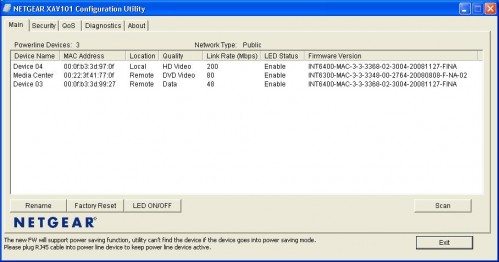


Gadgeteer Comment Policy - Please read before commenting
POSTSCRIPT..
I found the device that was causing the throughput problems at night. It was an LED night light with a photo sensor. It was in my computer room and only came on after dark and when I went to check out the link rate on the computer, I turned on the light in the room and the problem went away. Needless to say, I’ve launched the night light into outerspace. I am now happily streaming HD video (720p) over my house wiring using the powerline adapters without a problem. This is the easiest and most cost effective way to get ethernet throughout the house.
Bill
I’m using powerline Ethernet in my house to stream video, too. The technology works great! I found a solution from a company called Plaster Networks that includes an incredibly easy way to view the powerline network performance from your browser. (I found the NetGear utility quite difficult to use). The other thing they offer is something called an isolator that helps reduce the noise from appliances like the dryer. I have my power strip plugged into the isolator, and I saw a noticeable improvement in my powerline LAN performance.
>Tom,
Thanks for the info. Wasn’t aware of Plaster Networks before. I may just buy their performance monitor. I will assume it works with any brand of HomePlug AV gear.
Bill
This is great stuff and looks like a better value than the Netgear XAVB111. My application needs to run about in a range of about 150 meters. This effort is to get the wireless (sic) out to my boy’s classroom. As I understand transformers (step up or down) are death to this technology. I expect all this is down stream of that issue but as a K-5 school campus I don’t if they have a dryer! Any comments would be welcome. I am on Skype as RSmithsc; if a quick call will do use that. Thanks.